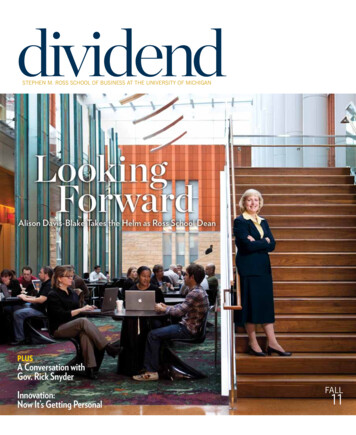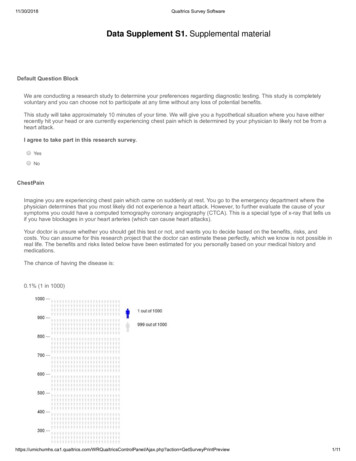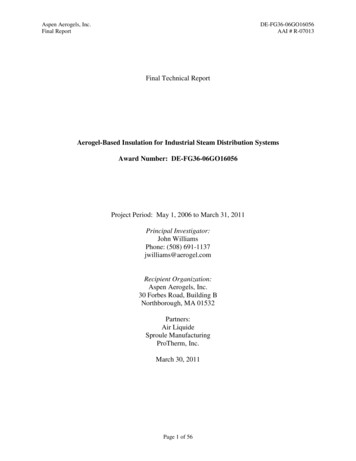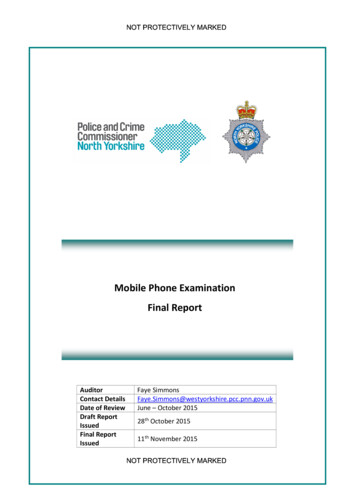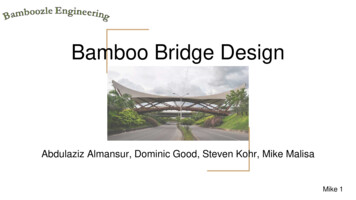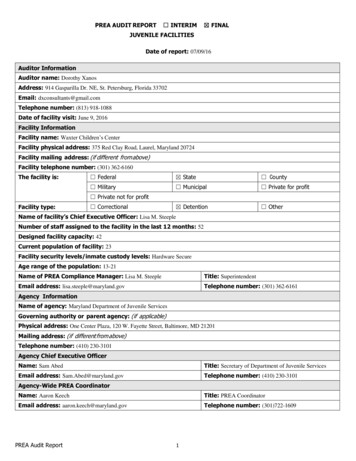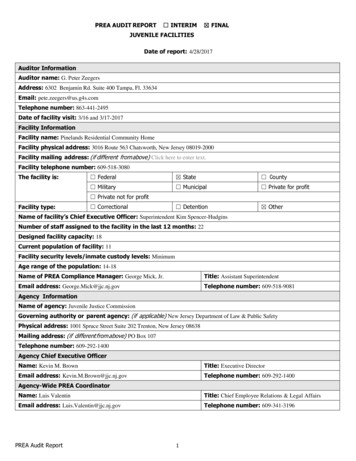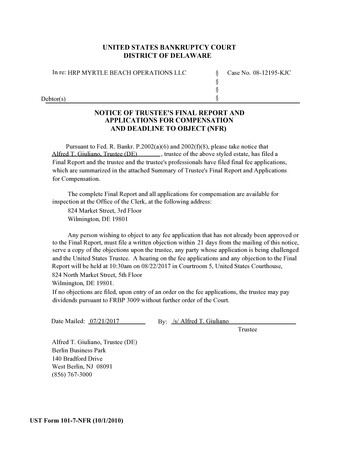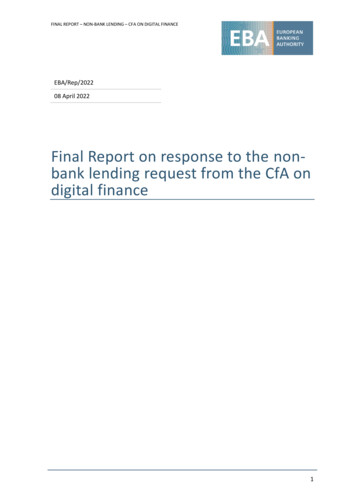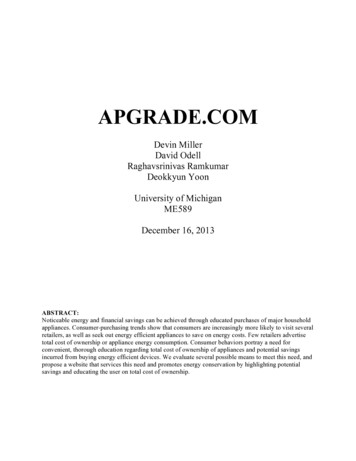
Transcription
APGRADE.COMDevin MillerDavid OdellRaghavsrinivas RamkumarDeokkyun YoonUniversity of MichiganME589December 16, 2013ABSTRACT:Noticeable energy and financial savings can be achieved through educated purchases of major householdappliances. Consumer-purchasing trends show that consumers are increasingly more likely to visit severalretailers, as well as seek out energy efficient appliances to save on energy costs. Few retailers advertisetotal cost of ownership or appliance energy consumption. Consumer behaviors portray a need forconvenient, thorough education regarding total cost of ownership of appliances and potential savingsincurred from buying energy efficient devices. We evaluate several possible means to meet this need, andpropose a website that services this need and promotes energy conservation by highlighting potentialsavings and educating the user on total cost of ownership.
EXECUTIVE SUMMARY . 4INTRODUCTION . 4DESCRIPTION OF BASELINE PRODUCT . 5EnergyGuide Label and ENERGY STAR .5Appliance Retailer’s Shopping Websites.6Project Goals .7DESIGN ETHNOGRAPHY. 7Household Appliance Market .7Ethnographic Research .8PERSONA . 9REQUIREMENTS AND SPECIFICATIONS . 10Overview .10Manufacturers and Retailers.10Consumer .10Weighting Requirements and Specifications .12SUSTAINABILITY EVALUATION PROCESS AND STATUS . 12Stakeholder network .12Use context .12Overview .13Social change and sustainability.13ENVIRONMENTAL IMPACT OF THE BASELINE . 13CONCEPT GENERATION METHODS . 14Overview of Concept Generation Process .14Models and Calculations .15Service Function .16Business Model for Revenue Generation .16CONCEPT REFINEMENT . 17Concept 1: Smartphone App .17Concept 2: Kiosk.17Concept 3: Website with Redirection .18Concept 4: Website with Pay Service .18Concept 5: Web Browser Extension .18CONCEPT SELECTION . 19ALPHA DESIGN . 21Website Layout .21Technical Functionality.26Business Model.27Comparison to Baseline .27FEEDBACK AND VALIDATION OF ALPHA DESIGN . 28FINAL CONCEPT . 292
BUSINESS PLAN . 33Company Description .33Market Analysis .34Product Description.35Market Penetration Strategy .36Communication Strategy .36Channels of Distribution .36Growth Strategy .36Financial Plan .36ADDITIONAL REFLECTIONS . 37Consistency with Sustainable Design .37Unintended Consequences .38Design Critique .39Strengths.39Weaknesses .39Recommendations.40Short-term recommendation .40Long-term recommendation .40ACKNOWLEDGEMENT . 41REFERENCES . 42APPENDIX 1: TEAM INTRODUCTION . 44APPENDIX 4: SAMPLE IMAGE OF BEST BUY ONLINE CATALOG . 46APPENDIX 5: PURCHASE BEHAVIORS AND ATTITUDES . 47APPENDIX 6: SALE OF APPLIANCES BY MAJOR RETAILERS . 48APPENDIX 7: REASONS FOR NEW PURCHASE . 49APPENDIX 8: IMPORTANCE OF PRODUCT ATTRIBUTES . 50APPENDIX 9: SPECIAL FEATURE INTEREST RANKINGS . 51APPENDIX 10: INTEREST IN PURCHASING ENERGY EFFICIENT PRODUCTS . 52APPENDIX 11: SAMPLE SURVEYS FOR CUSTOMER BEHAVIOR . 53Survey 1 .53Survey 2 .57APPENDIX 12: INTERVIEW 1 . 60APPENDIX 13: INTERVIEW 2 . 61APPENDIX 14: VALIDATION SURVEY . 62APPENDIX 15: ESTIMATED 3 YEAR FINANCIAL PLAN . 66APPENDIX 16: SELECTION OF REFRIGERATORS FROM BEST BUY . 68APPENDIX 17: ADDITIONAL PUGH CHARTS . 693
EXECUTIVE SUMMARYThe household appliance industry, including such appliances as refrigerators, dishwashers, washers, anddryers, is currently a 21.3 billion per year industry with major manufacturers and retailers vying formarket share. The industry operates by manufacturers selling products to retailers, who then handle mostof the advertising and reselling of the product to consumers. Each retailer has its own website listing theappliances it carries and allowing the customer to browse and filter results based on their needs.After researching customer purchasing behaviors and attitudes toward energy conservation, we found thatthe majority of customers will search online or visit multiple stores before selecting a product. This trendshows that consumers exhibit a need and desire to be educated on all available products and prices toreceive the best value. Regarding energy consumption, we found that the majority will only purchase anew major appliance if their old one broke, and not for the sole purpose of conserving energy. However,we found that most consumers are interested in appliances that are energy efficient, but are not willing topay the extra price.In order to begin developing concepts we built a list of requirements that our service needs to fulfill for itto be considered a success. These requirements were generated from our extended ethnographic research.Once we had the requirements we translated them into quantitative specifications for verificationpurposes. From this, we generated a number of concepts that would alter consumer’s buying behavior intoproducts with higher efficiency when making purchase decisions on these high-usage products. Webrainstormed a number of concepts for each sub-function of our service including medium of informationdelivery, technical functionality and business model. After concept generation of each sub-function, wedeveloped full service models and graded them against design criteria developed from our requirements ina Pugh chart. From all this, our team selected an alpha concept of a shopping website with a number ofnovel features related to energy usage would provide an efficient solution to consumers’ needs.After receiving feedback from our users and conducting follow up surveys showing our alpha design, wehave developed a final design. Our final design functions similar to a traditional shopping site, butprovides additional information to consumers that is not typically readily available. As a consumerbrowses our website, he/she receives the same price comparisons available from other sites, but also ispresented with energy efficiency and resultant adjusted cost information. The purpose of the website is toboth make users aware of these hidden intrinsic differences in lifetime cost and encourageenvironmentally conscious buying decisions. Currently, when it comes to cost, most retailer websitesleave users uneducated on how much per year they will have to pay in utilities for the appliance, as wellas how that compares to their current appliance. Our website will help to increase the willingness to payfor higher cost, more energy efficient appliances by incorporating statistics and functions to show the truecost of ownership, which may differ greatly than the sticker price. To evaluate the sustainability of thisservice we would need to conduct extended studies on the increase in number of people purchasingenergy efficient products through the use of our website. By determining this number we can translate thisto a reduction in societal carbon footprint. We have also included a number of short and long termrecommendations to further develop this product in the future.We have written an extensive business plan to accompany the product and make it successful in themarket. Our business plan includes a market analysis, market penetration strategy, communicationstrategy, channels of distribution, growth strategy, and financial projections over the next three years.This project has the potential to encourage millions of consumers to be more energy conscious with theirpurchases. We believe that our website will be a viable, market disrupting service that will be a successwithin the appliance retail industry and will lead to increased sales in energy efficient appliances.4
INTRODUCTIONHousehold appliances are a large source of energy consumption in any home today. Cutting down theenergy consumption of these appliances by purchasing more energy efficient products would result in asignificant decrease in monthly energy expenditure on these products. However, most people today areunwilling to spend extra to purchase these more efficient products. To solve this problem we aredesigning a service that would encourage consumers to pay the higher prices by showing them the truecost of ownership. We strongly believe that if people were better educated on the financial benefit ofenergy efficient products, they would be willing to change their habits.Currently, to appeal to energy-conscious customers, retailers such as Best Buy and Sears include energyratings of their products in their catalog. Consumers are given the choice to include Energy Starcertifications in their search filters and are provided an estimate on the energy consumption of theproducts they view. However, this information often does not convince customers to purchase a productwith higher energy efficiency. It has been found that only about 35% of consumers are buying ENERGYSTAR certified refrigerators each year. [7]Interviews with typical appliance consumers were conducted to supplement previously conducted worksand studies in ethnographic research. Several of the conclusions gathered from the interviews match theoutside research data. Additional new insights into the consumers’ mindset were gathered. Theseinterviews proved critical by supplying ideas for features and services to include on the proposed website.In order to help the consumers compare different options when they shop for a new appliance,Apgrade.com would provide more detailed information regarding ownership cost and environmentalimpact in addition to the already standard details. Currently, retailers’ websites do not show ownershipcost; thus the consumers would have to do ownership cost calculation on their own. With this in mind, theproposed business is aiming to provide additional data such as expected future operating cost associatedwith the new appliance and comparison to the consumers’ current appliance to ensure a greener shoppingexperience.Direct stakeholders to this business include appliance consumers and manufacturers, appliance retailers,and the host of the webserver. It is expected that the website would be directly affecting the consumers’decisions and in turn, modifying the market space by incentivizing manufacturers to design more energyefficient appliances and retailers to stock these products.DESCRIPTION OF BASELINE PRODUCTEnergyGuide Label and ENERGY STARThe baseline of our project is the EnergyGuide Label and Energy Star Certification. All the heating andcooling appliances including refrigerators must carry EnergyGuide label on them. The label includesestimated yearly energy use and ENERGY STAR certification status as seen in Figure 1.The energy consumption of a refrigerator is measured using the standard set forth by the Department ofEnergy using its test procedure [9]. ENERGY STAR certification is awarded based on the procedures setforth by Environmental Protection Agency and its affiliated partners [10]. ENERGY STAR certifiedproducts are more efficient than most of the products within the same category; however, the ENERGYSTAR label does not guarantee the lowest possible energy usage in a given category of products. Evenamong the products that are ENERGY STAR qualified, one product might be more energy efficient thanothers, but such factual information is not easily communicated to consumers. The consumers would needto spend their own time to rank the energy efficiency.5
Figure 1. EnergyGuide label of an ENERGY STAR certified Samsung refrigerator [8]As mandated by law, EnergyGuide label must be affixed to products retailers sell on their shop floor. Thelabel is usually visible when visiting retailers in person, however consumers may specifically need to lookfor the label on retailers’ or manufactures’ website under specification or literature page. By inspectingand comparing operating energy use and cost data on EnergyGuide label and creating their own database,consumers can compare different products’ efficiency levels. This added efficiency information could beused to estimate the yearly operating cost, but consumers must carry out the building and comparing dataprocedures on their own as there is no such service available.Appliance Retailer’s Shopping WebsitesAn indirect baseline to our project are websites of retailers who sell appliances. As of 2011, the UShousehold appliance1 market had total revenues of 21.3 billion [1]. With such a large market, severalretailers vie for position within the industry. The top five major retailers of kitchen appliances, by marketshare, are Sears (30.9%), Lowe’s (22.1%), Home Depot (14.6%), Best Buy (6.90%), and Walmart (3%)[4] (Appendix 6). Each of the main retailers hosts a website showcasing its appliances and online tools tohelp users choose which appliance best fits their needs. After benchmarking several of the major retailers’websites, we recognized several common features that assist in the users buying experience. For example,if one were to buy a refrigerator on Best Buy, they would first be prompted to select their desired1Kitchen appliances refers to refrigeration appliances, which include fridges, freezers and fridge freezers; cookingappliances, which include cookers, microwaves, ovens, cooker hoods, food processors and toasters; washingappliances, which include washing machines, clothes dryers and washer dryers; and dishwashers. The market valuehas been calculated using manufacturer selling prices.6
orientation (Side-by-Side, Top-Freezer, Bottom-Freezer, etc.) or go through Best Buy’s customRefrigerator Finder application. The Refrigerator Finder application is a shopping tool to help usersdecide which type of refrigerator they would like to buy, given their needs and desires. If they choose toselect an orientation, they would then be able to filter the selection of refrigerators by common qualitiessuch as customer reviews (1-5 stars), brand, price range, features, color, and dimensions. Users are alsoable to select multiple products to generate a side-by-side comparison of the product features andspecifications. In regards to energy savings, product descriptions are quick to mention their Energy Starcertification, and often include their estimated energy consumption, in kWh. We even found Best Buywent as far as to estimate the yearly operating costs for some of its products. However, these energyratings were typically buried deep within the specifications list, often found after scrolling toward thebottom of the page. Appendix 4 shows a screenshot of a typical Best Buy product page. After decidingwhich refrigerator to purchase, the user is directed to purchase warranties, payment plans, and to selectmethod of obtainment, either through delivery or store pick-up. This buying process is typical across allmajor retailers and appliances. The major retailers carry many of the most popular brands, but price,variety, and selection often varies greatly.Project GoalsAs indicated in subsequent sections, the majority of consumers are not buying energy efficient appliancesdue to the lack of easily accessible efficiency related cost information. The project design aims to providemore information to the consumers that their purchase decisions will gradually shift towards more energyefficient appliances; thus reducing overall energy usage. In turn, this may also encourage manufacturesand retailers to change production to favor more energy efficient appliances to comply with the marketshift. The goal of this project is ultimately encouraging sales and use of major appliances into a moresustainable direction.DESIGN ETHNOGRAPHYHousehold Appliance MarketSeveral key patterns and consumer-buying habits were found within the US home appliance marketthrough in-depth market research. All studies were conducted through a sample of approximately 2,000individuals, over the age of 18, and have access to the Internet [4]. The studies involve Washer and Dryeror Refrigerators, Freezers, and Dishwashers, but since the numbers are consistent across, the studies werecombined for a representation of the entire US household appliance market. Appendix 5 showspurchasing behaviors and attitudes before or during actual shopping. Of those who bought appliances inthe past two years, it showed that 28% visited multiple stores or did research online before visiting stores,and 27% waited for a sale. This included a 10% increase in the number who did research online beforevisiting stores, compared to who bought an appliance two or five years ago. This trend, combined with a4% increase in those who used a mobile phone to compare prices while shopping, shows a trend thatonline comparisons of products have become more prevalent among appliance consumers [4].Appendix 7 details the main reason for the consumers’ most recent purchase. Both tables show that themain reason for buying a new appliance is because the previous one broke down or needed significantrepair at 51%. This indicates that consumers are likely to hold onto their appliance for lengthy periods oftime or until it breaks. Only about 7% upgraded to save money on energy costs. Figure A in Appendix 7segments the responses by household income, and shows that household income has little impact onpurchase motivations, even among affluent customers. Although, there was a 3% increase among affluent( 150k ) customers who were willing to upgrade to save money on energy costs. Figure B separates theresponses by length of time since purchase. Figure B shows that energy conscious purchasing behaviorsare becoming more prevalent, as seen in the 7% increase in percentage of those more likely to upgrade tosave on money or energy costs, compared to those who purchased more than five years ago [4].7
Appendix 8 details the importance of product attributes, showing that reliability and price are the mostimportant attributes at 84% and 71%, respectively. Energy-efficiency rating is third at 58%. However,Appendix 9 details which special features consumers would be most likely to pay more for, and “Highestenergy-efficiency rating” topped the list at 38%. On the contrary, at 58%, the majorities of applianceowners are interested in the highest energy-efficiency rating, but are unwilling to pay for it [4]. Appendix10 shows that of all the energy efficient products on the market, consumers are very or somewhatinterested in buying major appliances, at 86%, only trailing light bulbs at 89% [2]. All of these statisticswell described the consumers’ attitudes and purchasing behaviors toward major appliances and aided theproject team develop ethnographic research paths.Ethnographic ResearchThe primary target demographic is people who use online/mobile shopping methods for purchasingappliances. These users don’t necessarily need to be environmentally conscious, the proposed serviceneeds to be useful to anyone who wishes to save money; virtually everyone is in this category. However,homeowners who are environmentally conscious might be especially interested in the proposed productsince it allows them to be economically conscious while possibly purchasing the appliance that is moreenergy efficient. The stakeholder base is even broader. Not only does it include all of the users, who standto benefit from more informed financial decision-making, but also retailers, manufacturers and anymiddle-men involved in the distribution of the products the service handles. While the stakeholdernetwork is broad, only those with specific experience in front-end and back-end web development areconsidered to be experts.From the market research it has been found that some services exist that allow consumers to compare andcontrast competing products. Ultimately though, none of the resources available on retailers’ websitesprovide comprehensive cross-competition comparisons or thorough cost and energy use analysis.Ethnographic studies were conducted to learn more about the online purchasing behavior of consumers. Asample of all the surveys can be seen in Appendix 11, 12 and 13.First, this study showed that online shoppers tend to search through multiple websites looking for the bestdeals and usually spend a lot of time doing so. When asked about using aggregators instead of individualretailer websites, most people said that they would gladly use it, assuming that the aggregator has beenproven to be trustworthy. This information indicates that the proposed service needs to ensure that itnever skimps on the accuracy of data being provided; the users will stop using the service if provenotherwise. When shown information on True Cost of Ownership (TCO) and Net Present Value (NPV),many of these consumers clearly expressed that this additional information would be extremely useful forthem to make a more informed purchase decision. Certain individuals surveyed did express their interestin knowing and understand the math that goes behind the NPV and TCO calculations so there needs aneasy way to express such data in a clear and concise fashion. In all, this survey provided key details on thebuying process and validated the initial assumption that current day consumers see potential in theproposed service.The ethnographic research supplemented much of what was found in the overall market research andsupplie
total cost of ownership or appliance energy consumption. Consumer behaviors portray a need for convenient, thorough education regarding total cost of ownership of appliances and potential savings incurred from buying energy efficient devices. We evaluate several possible means to meet this need, and
